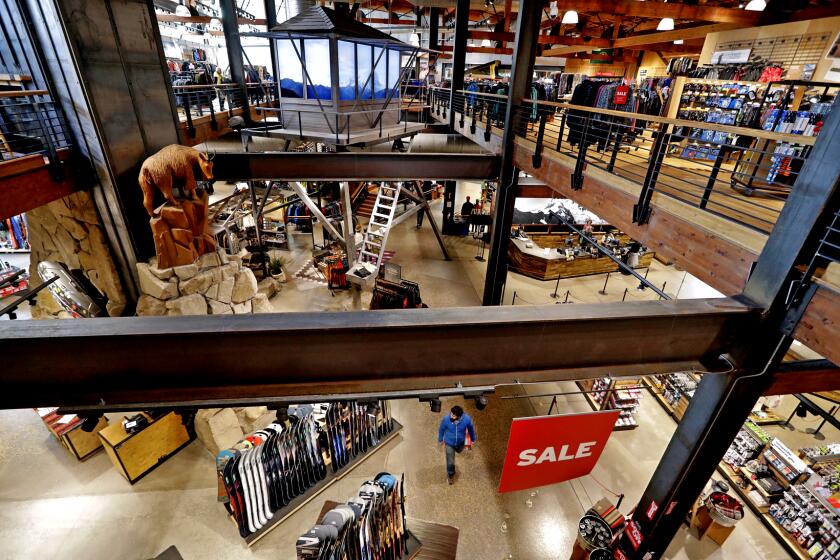The Inland Empire’s once-unstoppable warehousing industry falls into a slump

- Share via
For years the growth of warehousing in the Inland Empire was relentless. At the confluence of port-bound freeways and rail spurs along the eastern edge of Los Angeles’ sprawl, box-like fulfillment centers popped up in business parks by the millions of square feet. They were an economic engine, a bringer of jobs, a shortener of commutes, and a workhorse during the pandemic.
But now that’s come to a halt — bringing uncertainty for thousands of workers and an industry that has been an economic bellwether for the region.
After the COVID-19 pandemic slammed the nation in spring 2020, the Inland Empire recovered all of the jobs it lost by the summer of 2021 — more than a year ahead of Orange County and almost two years earlier than Los Angeles County. Despite pandemic restrictions, the area’s machinery of storing and transporting goods kicked into high gear, outpacing better-paying and more glamorous sectors in the state, such as entertainment and tech.
But the tables have turned in the last year. Warehousing and storage jobs in the Inland Empire shrank for the first time in more than two decades. Once-booming truck transportation has been down since early in the summer, and the area’s wholesale trade employment is dropping fast, according to year-over-year data from the U.S. Bureau of Labor Statistics. Industrial building vacancies are up and rents are down.
Logistics businesses nationally are cutting back amid declines in freight volume. United Parcel Service said it would shed 12,000 jobs worldwide over the next several months after more than a $9-billion drop in revenue last year. A company spokesman said it didn’t have a breakdown of where those layoffs would hit, but UPS employs tens of thousands of workers in California.
“Everything is different,” said Victor Ramirez, a Pomona resident who’s worked in warehousing for about 20 years. Speaking in Spanish, he remembered when times were better — much better.
The 59-year-old recalled not only getting full 40-hour workweeks in the past but bonuses during the pandemic. These days, things have slowed so much at his current place of employment, a warehouse that builds pallets, that he has taken on additional work as an Uber driver and canvasser for nonprofits.
“One job isn’t nearly enough,” Ramirez said.
With related business services and real estate also down, the Inland Empire’s overall job growth last year averaged just 1.2%, about half the rate for Southern California and the state as a whole. “We could be the weak link,” said John Husing, the region’s longtime economist based in Redlands.
Birth rates have been trending downward in the U.S. for several decades and dropped precipitously during the pandemic. A key reason is the high cost of raising kids.
The pandemic-induced surge of consumer purchases, transportation gridlock and prolonged labor negotiations at the ports all played a role in disrupting the flow of goods and exacerbating an oversupply of warehouses. But even before COVID, the industry was feeling increasing strains from environmental regulations, disputes over independent trucking and rising operating costs that have pushed more businesses to leave the state.
The Inland Empire’s troubles come as the U.S. economy faces an expected slowdown and the tech sector continues to shed jobs. California’s tourism industry, another big economic engine, hasn’t fully recovered, and high interest rates have taken a bite out of the housing market. All of that has left the state trailing the nation in job growth. The latest unemployment rate statewide, as well as for the Inland Empire, was 5.1% in December, well above the U.S. figure of 3.7%.
“Right now I am not an optimist on this economy,” Husing said.
The long shadow of logistics
Thanks to lower housing costs than in Los Angeles and Orange counties, the Inland Empire’s population has been growing for decades. Over the years, many residents found work in a logistics industry that has surged along with the region. Since 2000, the Inland Empire’s population has increased by 45% to 4.7 million last year. And jobs during that period have jumped even faster, up 68% to 1.7 million. That’s about as many as in all of Orange County.
A lot of that came on the back of the logistics industry, which got a big boost from soaring trade with China. Today, about 40% of all containers entering the U.S. from Asia are handled by the ports of L.A. and Long Beach. More than 37,000 heavy and tractor-trailer truck drivers based in the Inland Empire haul that cargo to rails and some 4,000 warehouses that are scattered across Riverside and San Bernardino counties’ 27,000 square miles, double the land area of the next largest metropolitan area, Phoenix-Scottsdale in Arizona.
The growing number of jobs brought the promise of greater economic security and quality of life as more residents were able to get jobs closer to home. But the growth of the logistics industry has exacerbated environmental concerns in communities with some of the least-healthful air in the United States. And analysts say too many households in the area are struggling to make ends meet as earnings have not kept up with rising costs.
Sheheryar Kaoosji, executive director of the nonprofit advocacy group Warehouse Worker Resource Center in Ontario, said many logistics jobs are still too close to minimum wage, are temporary or seasonal and are often quick to disappear when the economy softens.
“The average worker is always in a position of uncertainty,” he said.
For all occupations, Inland Empire workers made $27.96 an hour on average in 2022, the latest according to the Bureau of Labor Statistics. That is compared with $33.43 for L.A. and Orange counties combined, and $45.37 for the San Francisco Bay Area.
More than 270,000 people in the Inland Empire work in transportation and material moving occupations. Their median hourly pay in 2022: $21.13. Stockers and order fillers made even less — $19.01 an hour, on average.
California’s statewide minimum wage for larger employers was $15 an hour in 2022. It went up to $16 this year, and for fast-food workers it’ll go to $20 an hour in April.
“It’s a good starter job, but as far as long-term, a lot of people think they’re going to do it for life,” said Byron Williams, 48, of Moreno Valley, referring to logistics jobs at Amazon.
Williams once worked at Amazon, though on the finance side of logistics. The e-commerce behemoth operates more than a dozen distribution facilities in the Inland Empire. Williams said he left because of the pay. “It’s not a for-life position.”
The new boom and bust
Going through boom and bust cycles has been part and parcel of life in the Inland Empire. The area tumbled during the early 1990s downturn that was marked by defense cuts and overbuilding. And it was one of the hardest hit by the subprime mortgage crisis that brought the Great Recession in 2007-09.
The pandemic, at first, seemed to be an exception. The Inland Empire’s economy quickly rebounded thanks to surging orders for all kinds of stuff from people stuck in their homes. Rounds of government stimulus checks added fuel to consumer spending.
But in the last year the industry suddenly fell back, in part as consumer spending shifted more to services, such as travel and entertainment , and less on things such as cars and groceries. High inflation also was a factor, as was the unusual situation at the ports.
Early in the pandemic, dozens of ships were lined up at sea waiting to berth in L.A. and Long Beach ports. When the logjam eased, merchandise flooded into the region, prompting wholesalers and distributors to double down on warehouses and workers.
“We couldn’t hire fast enough,” said Jeff Baldassari, who until August was president of U.S. Rubber Recycling in Colton, which got a burst of pandemic orders of rubber mats for in-home gyms and other uses. “Now the party ended, and it’s the hangover the next day,” he said.
Drawn-out labor talks with longshoremen that lasted more than a year prompted some companies to divert cargo to the East and Gulf Coast ports.
In the last few months, warehouses and distribution centers have shut down in Rialto, Fontana, Jurupa Valley, Perris and Chino, among other cities, according to WARN Act filings with the state. During the summer, the bankrupt trucking firm Yellow Corp. shuttered several terminals in the Inland Empire that eliminated about 1,000 jobs.
The downturn in logistics has spread to other industries too, including finance and real estate. San Francisco-based Prologis, the world’s biggest warehouse developer and a major player in the Inland Empire, reported a 7% drop in rents in the fourth quarter for Southern California. The company said its construction pipeline in the region was half of what it was at year-end 2022.
During a recent conference call with analysts, Prologis’ chief executive, Hamid Moghadam, said it’s always been difficult for retailers and wholesalers to correctly forecast demand and manage inventories. “They’re schizophrenic. They always have too much or too little. You can never get it right.”
Outdoor retail giant REI is closing its Santa Monica location Feb. 29. It recently opened a store in nearby Marina del Rey.
Still, he and other developers said they are bullish on the future. The logistics business in Southern California is getting back on its feet after the pandemic, they said. And key drivers of growth remain intact — e-commerce, global trade, demand for larger, more efficient distribution centers, said Iddo Benzeevi, chief executive of Highland Fairview, a developer working on a massive logistics center in Moreno Valley.
But that will also bring more consolidation, he said. Older, smaller facilities will get phased out, and payrolls aren’t likely to grow as fast as before. In the long term, logistics jobs may require higher skills and pay better as facilities become more automated and employ technologies such as driverless trucks — but they could employ fewer workers.

For truck driver Mauricio Perez, a 15-year veteran at UPS who lives in Rancho Cucamonga, it’s the near term that worries him.
Work usually slows after the busy Christmas season, but he said this year looks different. During the holidays, Perez saw 53-foot trailers stacked to the brim with items and packages to be delivered. Nowadays, 28-foot trailers have barely two or three pallets inside.
What’s more, he said that the work-bidding process at UPS suggests that a lot more truckers in the Inland Empire are likely to be on a more flexible schedule that can vary week to week or shunted to the package hub, where they’d work fewer hours. That means drivers who don’t get assigned work may end up taking a “layoff week,” in which they won’t get paid unless they cash out vacation time or accrue pension benefits.
“It’s not looking like the economy is going to get any better in the next few months,” Perez said. “We just gotta brace ourselves for the worst.”
More to Read
Inside the business of entertainment
The Wide Shot brings you news, analysis and insights on everything from streaming wars to production — and what it all means for the future.
You may occasionally receive promotional content from the Los Angeles Times.














